Analysis of Operations Management Principles at TESCO and Crossrail
VerifiedAdded on 2022/12/28
|18
|4867
|58
Report
AI Summary
This report provides a comprehensive analysis of operations and project management principles, focusing on their application within the context of TESCO and the Crossrail project. The report begins with a critical review of TESCO's operational management practices, evaluating the implementation of key principles such as accountability, causality, and organization. It explores the use of lean production and Six Sigma methodologies, examining their pros and cons. Furthermore, the report details a continuous improvement plan based on the review, highlighting strategies for long-term growth. The second part of the report applies the product life cycle (PLC) to the Crossrail project, documenting each stage and providing supporting documentation. Finally, it critiques the effectiveness of the PLC in the chosen project using relevant theories and models, offering a well-rounded perspective on operations and project management in a real-world setting.
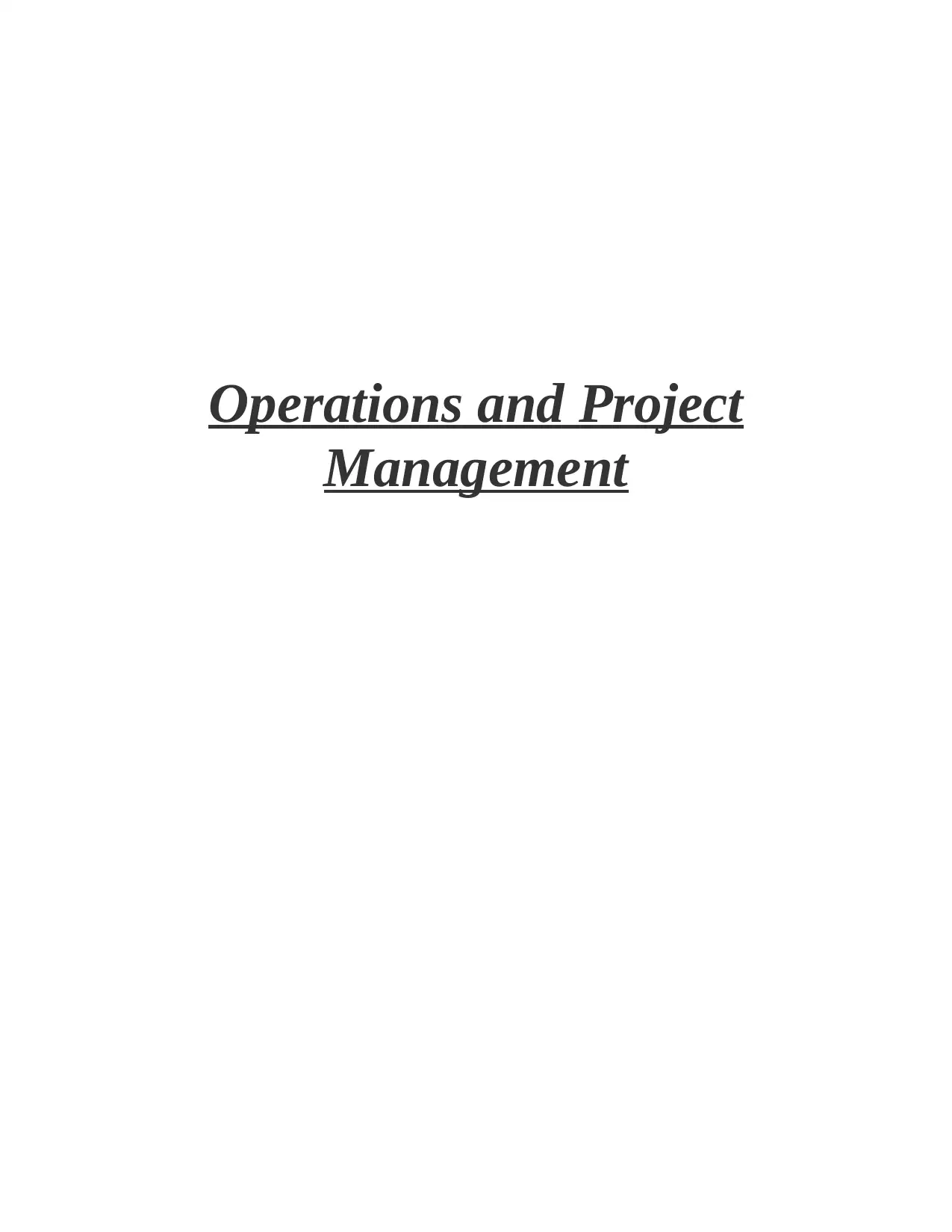
Operations and Project
Management
Management
Paraphrase This Document
Need a fresh take? Get an instant paraphrase of this document with our AI Paraphraser
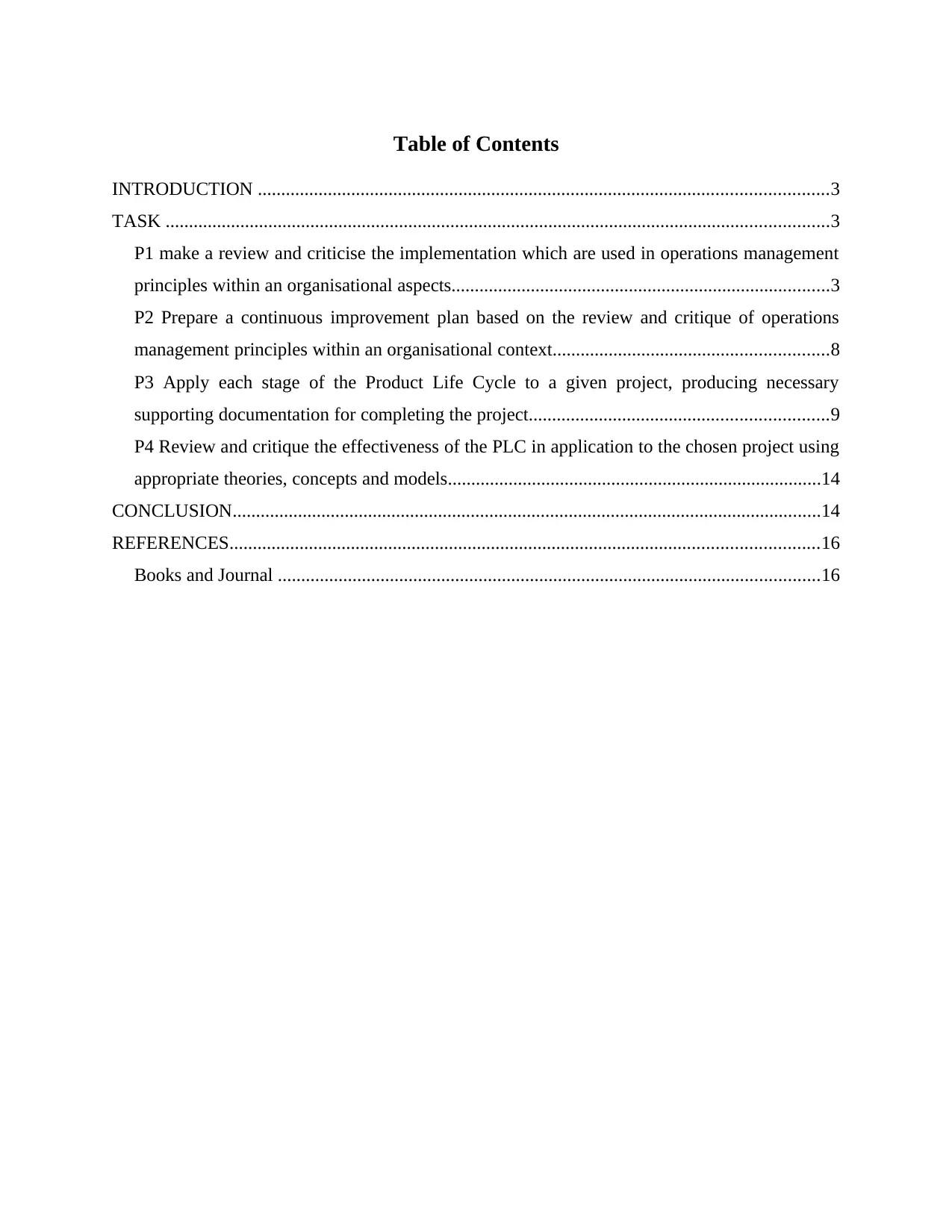
Table of Contents
INTRODUCTION ..........................................................................................................................3
TASK ..............................................................................................................................................3
P1 make a review and criticise the implementation which are used in operations management
principles within an organisational aspects.................................................................................3
P2 Prepare a continuous improvement plan based on the review and critique of operations
management principles within an organisational context...........................................................8
P3 Apply each stage of the Product Life Cycle to a given project, producing necessary
supporting documentation for completing the project................................................................9
P4 Review and critique the effectiveness of the PLC in application to the chosen project using
appropriate theories, concepts and models................................................................................14
CONCLUSION..............................................................................................................................14
REFERENCES..............................................................................................................................16
Books and Journal ....................................................................................................................16
INTRODUCTION ..........................................................................................................................3
TASK ..............................................................................................................................................3
P1 make a review and criticise the implementation which are used in operations management
principles within an organisational aspects.................................................................................3
P2 Prepare a continuous improvement plan based on the review and critique of operations
management principles within an organisational context...........................................................8
P3 Apply each stage of the Product Life Cycle to a given project, producing necessary
supporting documentation for completing the project................................................................9
P4 Review and critique the effectiveness of the PLC in application to the chosen project using
appropriate theories, concepts and models................................................................................14
CONCLUSION..............................................................................................................................14
REFERENCES..............................................................................................................................16
Books and Journal ....................................................................................................................16
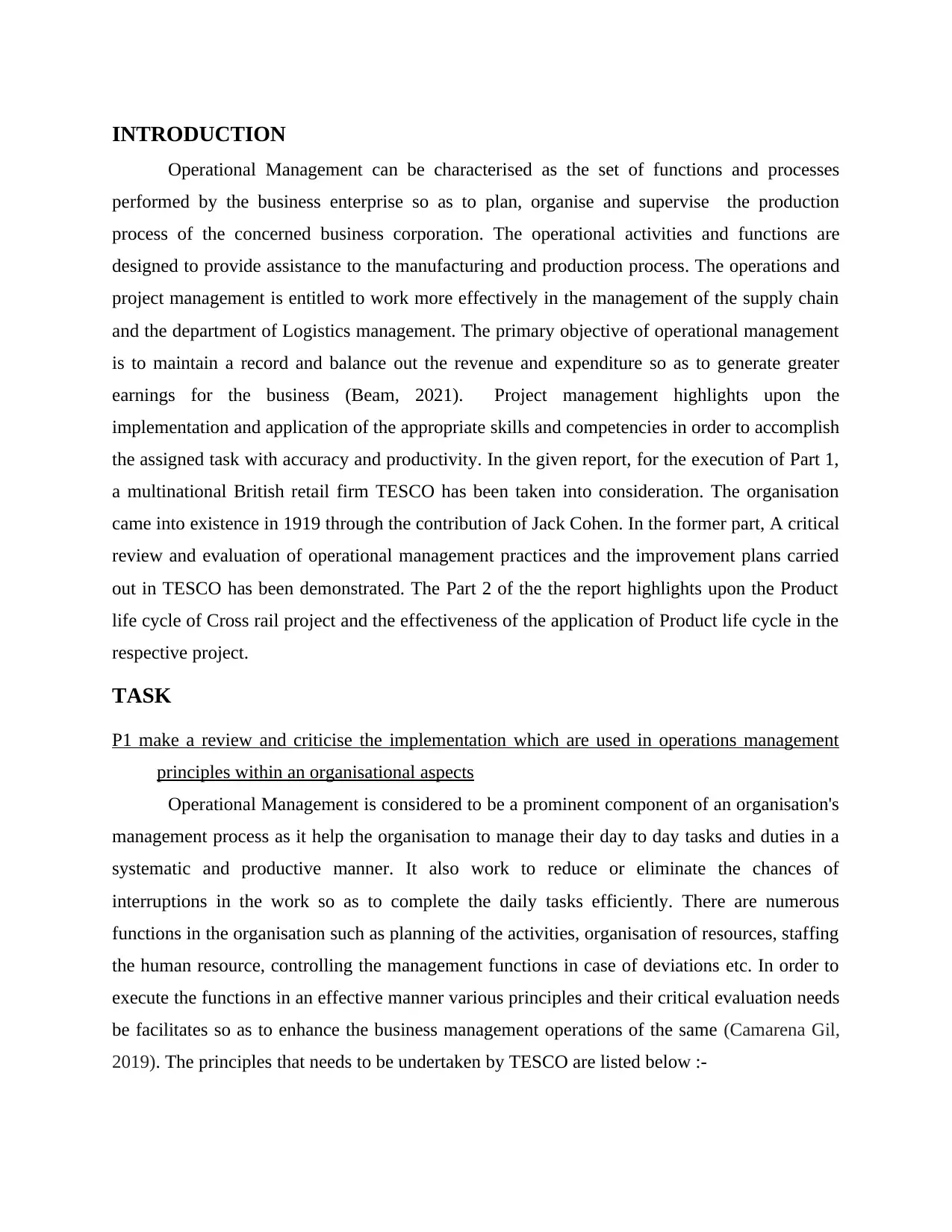
INTRODUCTION
Operational Management can be characterised as the set of functions and processes
performed by the business enterprise so as to plan, organise and supervise the production
process of the concerned business corporation. The operational activities and functions are
designed to provide assistance to the manufacturing and production process. The operations and
project management is entitled to work more effectively in the management of the supply chain
and the department of Logistics management. The primary objective of operational management
is to maintain a record and balance out the revenue and expenditure so as to generate greater
earnings for the business (Beam, 2021). Project management highlights upon the
implementation and application of the appropriate skills and competencies in order to accomplish
the assigned task with accuracy and productivity. In the given report, for the execution of Part 1,
a multinational British retail firm TESCO has been taken into consideration. The organisation
came into existence in 1919 through the contribution of Jack Cohen. In the former part, A critical
review and evaluation of operational management practices and the improvement plans carried
out in TESCO has been demonstrated. The Part 2 of the the report highlights upon the Product
life cycle of Cross rail project and the effectiveness of the application of Product life cycle in the
respective project.
TASK
P1 make a review and criticise the implementation which are used in operations management
principles within an organisational aspects
Operational Management is considered to be a prominent component of an organisation's
management process as it help the organisation to manage their day to day tasks and duties in a
systematic and productive manner. It also work to reduce or eliminate the chances of
interruptions in the work so as to complete the daily tasks efficiently. There are numerous
functions in the organisation such as planning of the activities, organisation of resources, staffing
the human resource, controlling the management functions in case of deviations etc. In order to
execute the functions in an effective manner various principles and their critical evaluation needs
be facilitates so as to enhance the business management operations of the same (Camarena Gil,
2019). The principles that needs to be undertaken by TESCO are listed below :-
Operational Management can be characterised as the set of functions and processes
performed by the business enterprise so as to plan, organise and supervise the production
process of the concerned business corporation. The operational activities and functions are
designed to provide assistance to the manufacturing and production process. The operations and
project management is entitled to work more effectively in the management of the supply chain
and the department of Logistics management. The primary objective of operational management
is to maintain a record and balance out the revenue and expenditure so as to generate greater
earnings for the business (Beam, 2021). Project management highlights upon the
implementation and application of the appropriate skills and competencies in order to accomplish
the assigned task with accuracy and productivity. In the given report, for the execution of Part 1,
a multinational British retail firm TESCO has been taken into consideration. The organisation
came into existence in 1919 through the contribution of Jack Cohen. In the former part, A critical
review and evaluation of operational management practices and the improvement plans carried
out in TESCO has been demonstrated. The Part 2 of the the report highlights upon the Product
life cycle of Cross rail project and the effectiveness of the application of Product life cycle in the
respective project.
TASK
P1 make a review and criticise the implementation which are used in operations management
principles within an organisational aspects
Operational Management is considered to be a prominent component of an organisation's
management process as it help the organisation to manage their day to day tasks and duties in a
systematic and productive manner. It also work to reduce or eliminate the chances of
interruptions in the work so as to complete the daily tasks efficiently. There are numerous
functions in the organisation such as planning of the activities, organisation of resources, staffing
the human resource, controlling the management functions in case of deviations etc. In order to
execute the functions in an effective manner various principles and their critical evaluation needs
be facilitates so as to enhance the business management operations of the same (Camarena Gil,
2019). The principles that needs to be undertaken by TESCO are listed below :-
⊘ This is a preview!⊘
Do you want full access?
Subscribe today to unlock all pages.

Trusted by 1+ million students worldwide
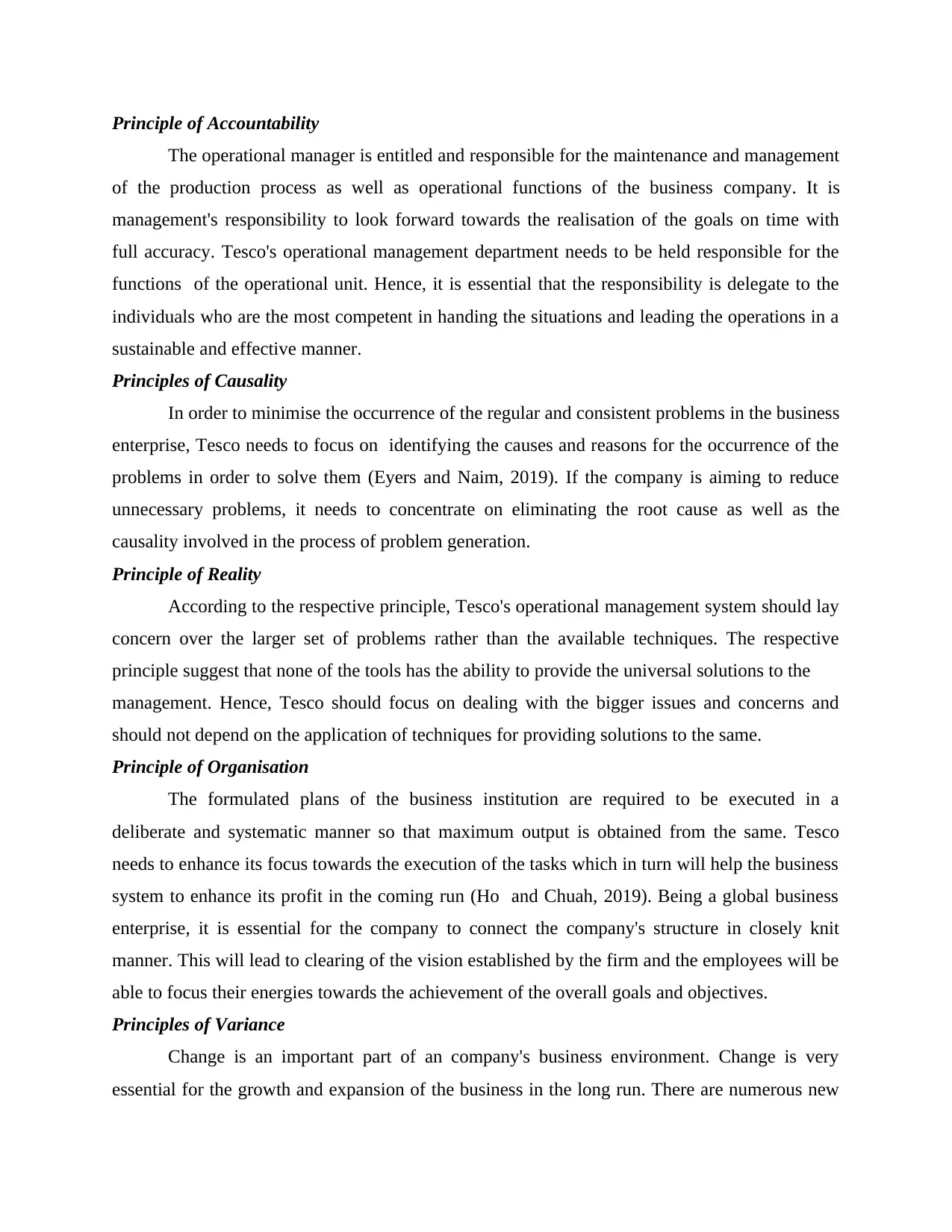
Principle of Accountability
The operational manager is entitled and responsible for the maintenance and management
of the production process as well as operational functions of the business company. It is
management's responsibility to look forward towards the realisation of the goals on time with
full accuracy. Tesco's operational management department needs to be held responsible for the
functions of the operational unit. Hence, it is essential that the responsibility is delegate to the
individuals who are the most competent in handing the situations and leading the operations in a
sustainable and effective manner.
Principles of Causality
In order to minimise the occurrence of the regular and consistent problems in the business
enterprise, Tesco needs to focus on identifying the causes and reasons for the occurrence of the
problems in order to solve them (Eyers and Naim, 2019). If the company is aiming to reduce
unnecessary problems, it needs to concentrate on eliminating the root cause as well as the
causality involved in the process of problem generation.
Principle of Reality
According to the respective principle, Tesco's operational management system should lay
concern over the larger set of problems rather than the available techniques. The respective
principle suggest that none of the tools has the ability to provide the universal solutions to the
management. Hence, Tesco should focus on dealing with the bigger issues and concerns and
should not depend on the application of techniques for providing solutions to the same.
Principle of Organisation
The formulated plans of the business institution are required to be executed in a
deliberate and systematic manner so that maximum output is obtained from the same. Tesco
needs to enhance its focus towards the execution of the tasks which in turn will help the business
system to enhance its profit in the coming run (Ho and Chuah, 2019). Being a global business
enterprise, it is essential for the company to connect the company's structure in closely knit
manner. This will lead to clearing of the vision established by the firm and the employees will be
able to focus their energies towards the achievement of the overall goals and objectives.
Principles of Variance
Change is an important part of an company's business environment. Change is very
essential for the growth and expansion of the business in the long run. There are numerous new
The operational manager is entitled and responsible for the maintenance and management
of the production process as well as operational functions of the business company. It is
management's responsibility to look forward towards the realisation of the goals on time with
full accuracy. Tesco's operational management department needs to be held responsible for the
functions of the operational unit. Hence, it is essential that the responsibility is delegate to the
individuals who are the most competent in handing the situations and leading the operations in a
sustainable and effective manner.
Principles of Causality
In order to minimise the occurrence of the regular and consistent problems in the business
enterprise, Tesco needs to focus on identifying the causes and reasons for the occurrence of the
problems in order to solve them (Eyers and Naim, 2019). If the company is aiming to reduce
unnecessary problems, it needs to concentrate on eliminating the root cause as well as the
causality involved in the process of problem generation.
Principle of Reality
According to the respective principle, Tesco's operational management system should lay
concern over the larger set of problems rather than the available techniques. The respective
principle suggest that none of the tools has the ability to provide the universal solutions to the
management. Hence, Tesco should focus on dealing with the bigger issues and concerns and
should not depend on the application of techniques for providing solutions to the same.
Principle of Organisation
The formulated plans of the business institution are required to be executed in a
deliberate and systematic manner so that maximum output is obtained from the same. Tesco
needs to enhance its focus towards the execution of the tasks which in turn will help the business
system to enhance its profit in the coming run (Ho and Chuah, 2019). Being a global business
enterprise, it is essential for the company to connect the company's structure in closely knit
manner. This will lead to clearing of the vision established by the firm and the employees will be
able to focus their energies towards the achievement of the overall goals and objectives.
Principles of Variance
Change is an important part of an company's business environment. Change is very
essential for the growth and expansion of the business in the long run. There are numerous new
Paraphrase This Document
Need a fresh take? Get an instant paraphrase of this document with our AI Paraphraser
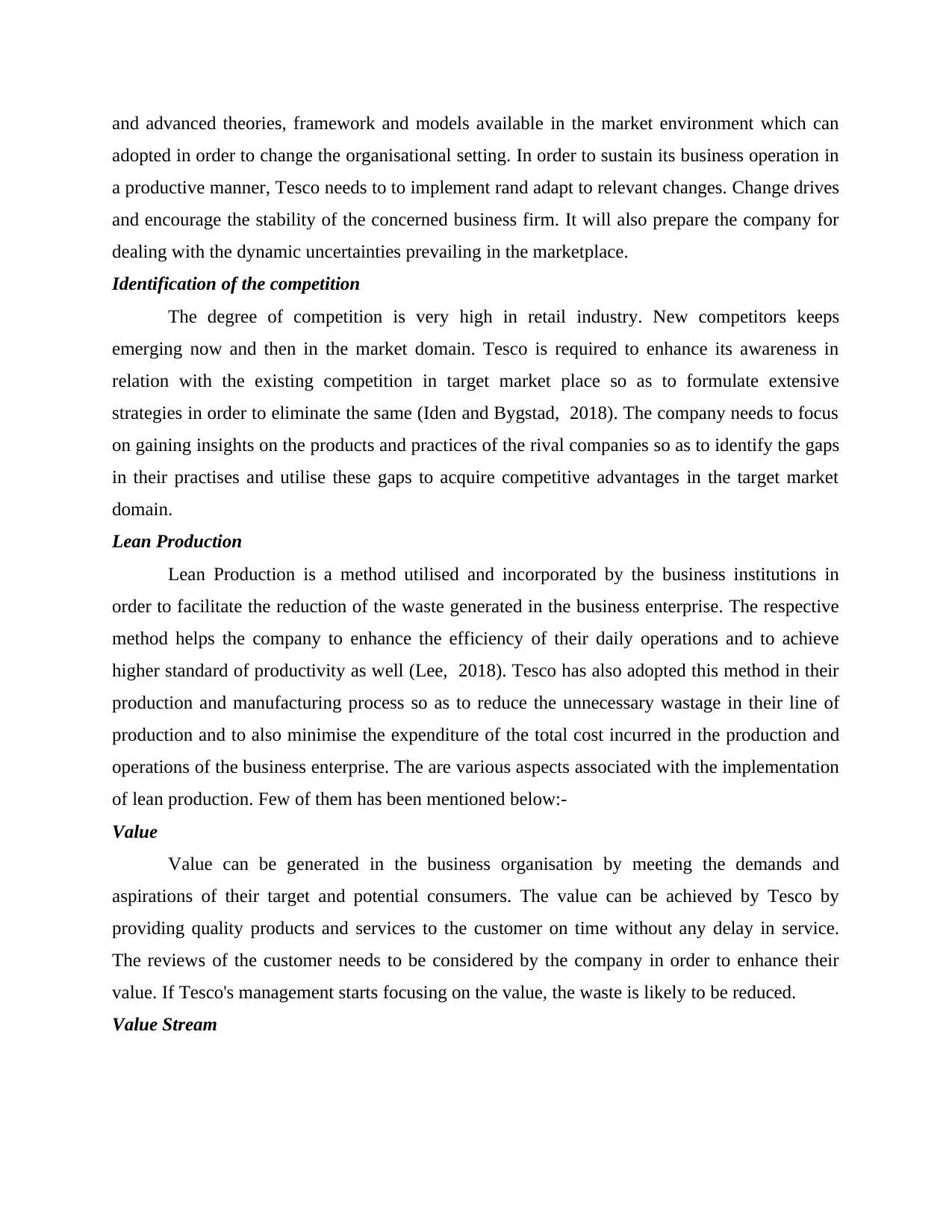
and advanced theories, framework and models available in the market environment which can
adopted in order to change the organisational setting. In order to sustain its business operation in
a productive manner, Tesco needs to to implement rand adapt to relevant changes. Change drives
and encourage the stability of the concerned business firm. It will also prepare the company for
dealing with the dynamic uncertainties prevailing in the marketplace.
Identification of the competition
The degree of competition is very high in retail industry. New competitors keeps
emerging now and then in the market domain. Tesco is required to enhance its awareness in
relation with the existing competition in target market place so as to formulate extensive
strategies in order to eliminate the same (Iden and Bygstad, 2018). The company needs to focus
on gaining insights on the products and practices of the rival companies so as to identify the gaps
in their practises and utilise these gaps to acquire competitive advantages in the target market
domain.
Lean Production
Lean Production is a method utilised and incorporated by the business institutions in
order to facilitate the reduction of the waste generated in the business enterprise. The respective
method helps the company to enhance the efficiency of their daily operations and to achieve
higher standard of productivity as well (Lee, 2018). Tesco has also adopted this method in their
production and manufacturing process so as to reduce the unnecessary wastage in their line of
production and to also minimise the expenditure of the total cost incurred in the production and
operations of the business enterprise. The are various aspects associated with the implementation
of lean production. Few of them has been mentioned below:-
Value
Value can be generated in the business organisation by meeting the demands and
aspirations of their target and potential consumers. The value can be achieved by Tesco by
providing quality products and services to the customer on time without any delay in service.
The reviews of the customer needs to be considered by the company in order to enhance their
value. If Tesco's management starts focusing on the value, the waste is likely to be reduced.
Value Stream
adopted in order to change the organisational setting. In order to sustain its business operation in
a productive manner, Tesco needs to to implement rand adapt to relevant changes. Change drives
and encourage the stability of the concerned business firm. It will also prepare the company for
dealing with the dynamic uncertainties prevailing in the marketplace.
Identification of the competition
The degree of competition is very high in retail industry. New competitors keeps
emerging now and then in the market domain. Tesco is required to enhance its awareness in
relation with the existing competition in target market place so as to formulate extensive
strategies in order to eliminate the same (Iden and Bygstad, 2018). The company needs to focus
on gaining insights on the products and practices of the rival companies so as to identify the gaps
in their practises and utilise these gaps to acquire competitive advantages in the target market
domain.
Lean Production
Lean Production is a method utilised and incorporated by the business institutions in
order to facilitate the reduction of the waste generated in the business enterprise. The respective
method helps the company to enhance the efficiency of their daily operations and to achieve
higher standard of productivity as well (Lee, 2018). Tesco has also adopted this method in their
production and manufacturing process so as to reduce the unnecessary wastage in their line of
production and to also minimise the expenditure of the total cost incurred in the production and
operations of the business enterprise. The are various aspects associated with the implementation
of lean production. Few of them has been mentioned below:-
Value
Value can be generated in the business organisation by meeting the demands and
aspirations of their target and potential consumers. The value can be achieved by Tesco by
providing quality products and services to the customer on time without any delay in service.
The reviews of the customer needs to be considered by the company in order to enhance their
value. If Tesco's management starts focusing on the value, the waste is likely to be reduced.
Value Stream
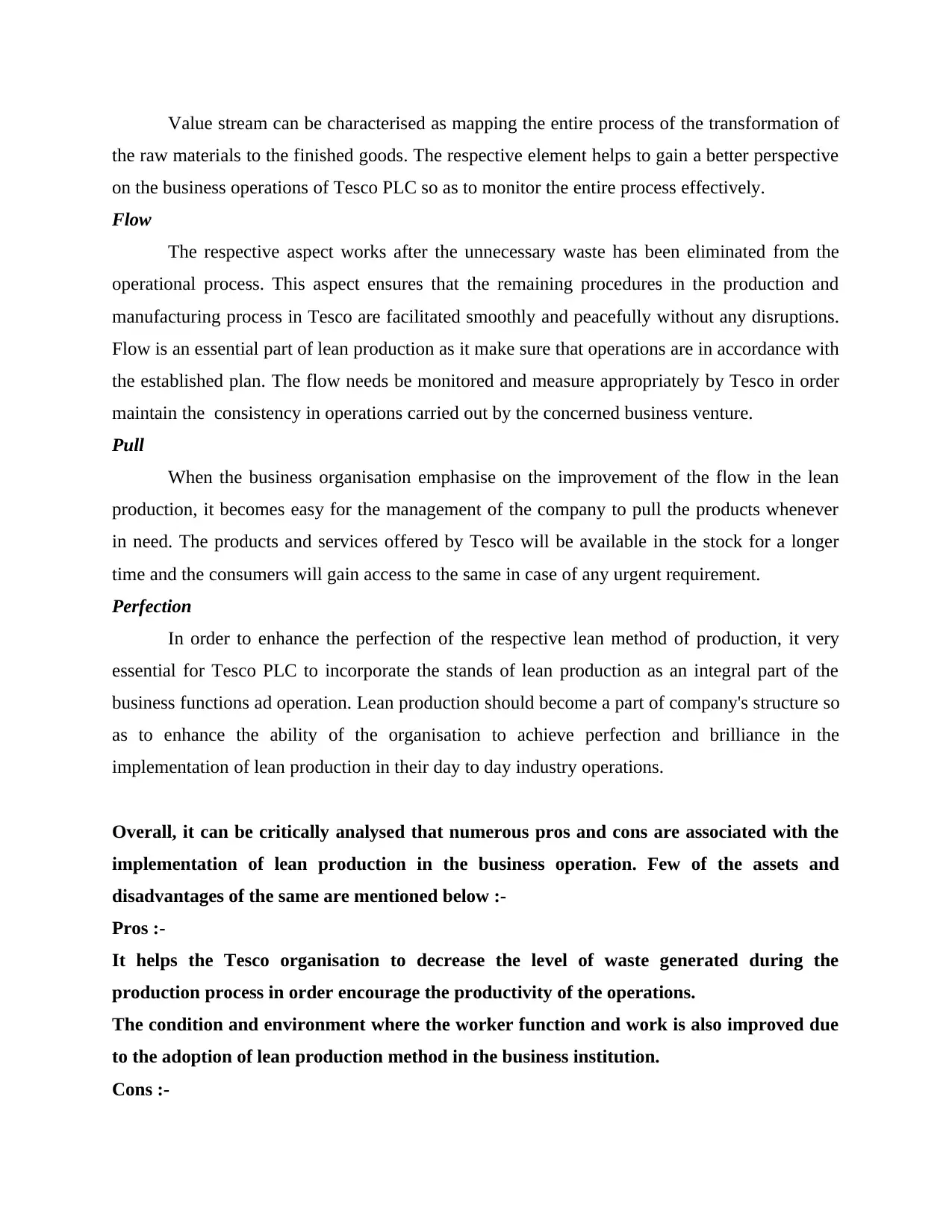
Value stream can be characterised as mapping the entire process of the transformation of
the raw materials to the finished goods. The respective element helps to gain a better perspective
on the business operations of Tesco PLC so as to monitor the entire process effectively.
Flow
The respective aspect works after the unnecessary waste has been eliminated from the
operational process. This aspect ensures that the remaining procedures in the production and
manufacturing process in Tesco are facilitated smoothly and peacefully without any disruptions.
Flow is an essential part of lean production as it make sure that operations are in accordance with
the established plan. The flow needs be monitored and measure appropriately by Tesco in order
maintain the consistency in operations carried out by the concerned business venture.
Pull
When the business organisation emphasise on the improvement of the flow in the lean
production, it becomes easy for the management of the company to pull the products whenever
in need. The products and services offered by Tesco will be available in the stock for a longer
time and the consumers will gain access to the same in case of any urgent requirement.
Perfection
In order to enhance the perfection of the respective lean method of production, it very
essential for Tesco PLC to incorporate the stands of lean production as an integral part of the
business functions ad operation. Lean production should become a part of company's structure so
as to enhance the ability of the organisation to achieve perfection and brilliance in the
implementation of lean production in their day to day industry operations.
Overall, it can be critically analysed that numerous pros and cons are associated with the
implementation of lean production in the business operation. Few of the assets and
disadvantages of the same are mentioned below :-
Pros :-
It helps the Tesco organisation to decrease the level of waste generated during the
production process in order encourage the productivity of the operations.
The condition and environment where the worker function and work is also improved due
to the adoption of lean production method in the business institution.
Cons :-
the raw materials to the finished goods. The respective element helps to gain a better perspective
on the business operations of Tesco PLC so as to monitor the entire process effectively.
Flow
The respective aspect works after the unnecessary waste has been eliminated from the
operational process. This aspect ensures that the remaining procedures in the production and
manufacturing process in Tesco are facilitated smoothly and peacefully without any disruptions.
Flow is an essential part of lean production as it make sure that operations are in accordance with
the established plan. The flow needs be monitored and measure appropriately by Tesco in order
maintain the consistency in operations carried out by the concerned business venture.
Pull
When the business organisation emphasise on the improvement of the flow in the lean
production, it becomes easy for the management of the company to pull the products whenever
in need. The products and services offered by Tesco will be available in the stock for a longer
time and the consumers will gain access to the same in case of any urgent requirement.
Perfection
In order to enhance the perfection of the respective lean method of production, it very
essential for Tesco PLC to incorporate the stands of lean production as an integral part of the
business functions ad operation. Lean production should become a part of company's structure so
as to enhance the ability of the organisation to achieve perfection and brilliance in the
implementation of lean production in their day to day industry operations.
Overall, it can be critically analysed that numerous pros and cons are associated with the
implementation of lean production in the business operation. Few of the assets and
disadvantages of the same are mentioned below :-
Pros :-
It helps the Tesco organisation to decrease the level of waste generated during the
production process in order encourage the productivity of the operations.
The condition and environment where the worker function and work is also improved due
to the adoption of lean production method in the business institution.
Cons :-
⊘ This is a preview!⊘
Do you want full access?
Subscribe today to unlock all pages.

Trusted by 1+ million students worldwide
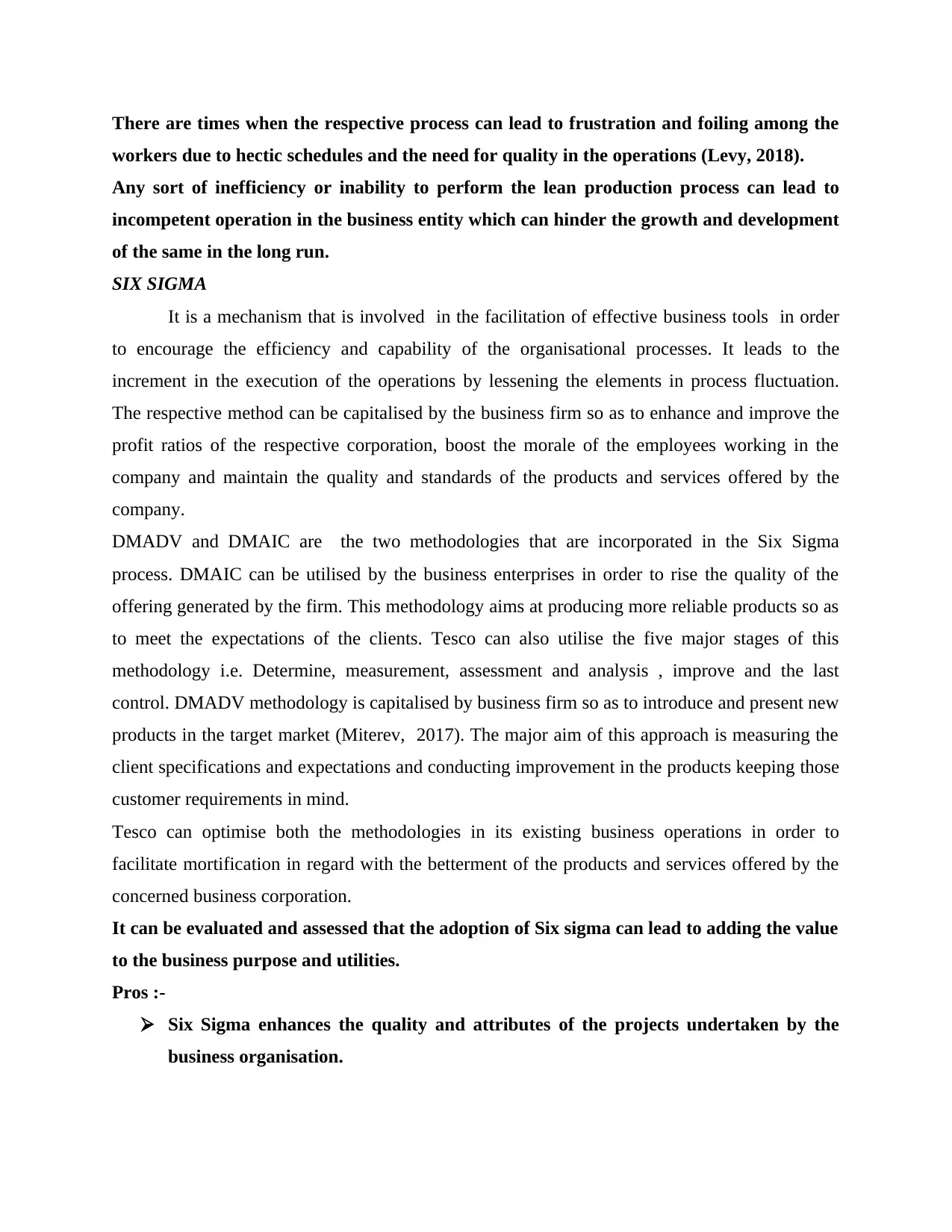
There are times when the respective process can lead to frustration and foiling among the
workers due to hectic schedules and the need for quality in the operations (Levy, 2018).
Any sort of inefficiency or inability to perform the lean production process can lead to
incompetent operation in the business entity which can hinder the growth and development
of the same in the long run.
SIX SIGMA
It is a mechanism that is involved in the facilitation of effective business tools in order
to encourage the efficiency and capability of the organisational processes. It leads to the
increment in the execution of the operations by lessening the elements in process fluctuation.
The respective method can be capitalised by the business firm so as to enhance and improve the
profit ratios of the respective corporation, boost the morale of the employees working in the
company and maintain the quality and standards of the products and services offered by the
company.
DMADV and DMAIC are the two methodologies that are incorporated in the Six Sigma
process. DMAIC can be utilised by the business enterprises in order to rise the quality of the
offering generated by the firm. This methodology aims at producing more reliable products so as
to meet the expectations of the clients. Tesco can also utilise the five major stages of this
methodology i.e. Determine, measurement, assessment and analysis , improve and the last
control. DMADV methodology is capitalised by business firm so as to introduce and present new
products in the target market (Miterev, 2017). The major aim of this approach is measuring the
client specifications and expectations and conducting improvement in the products keeping those
customer requirements in mind.
Tesco can optimise both the methodologies in its existing business operations in order to
facilitate mortification in regard with the betterment of the products and services offered by the
concerned business corporation.
It can be evaluated and assessed that the adoption of Six sigma can lead to adding the value
to the business purpose and utilities.
Pros :-
Six Sigma enhances the quality and attributes of the projects undertaken by the
business organisation.
workers due to hectic schedules and the need for quality in the operations (Levy, 2018).
Any sort of inefficiency or inability to perform the lean production process can lead to
incompetent operation in the business entity which can hinder the growth and development
of the same in the long run.
SIX SIGMA
It is a mechanism that is involved in the facilitation of effective business tools in order
to encourage the efficiency and capability of the organisational processes. It leads to the
increment in the execution of the operations by lessening the elements in process fluctuation.
The respective method can be capitalised by the business firm so as to enhance and improve the
profit ratios of the respective corporation, boost the morale of the employees working in the
company and maintain the quality and standards of the products and services offered by the
company.
DMADV and DMAIC are the two methodologies that are incorporated in the Six Sigma
process. DMAIC can be utilised by the business enterprises in order to rise the quality of the
offering generated by the firm. This methodology aims at producing more reliable products so as
to meet the expectations of the clients. Tesco can also utilise the five major stages of this
methodology i.e. Determine, measurement, assessment and analysis , improve and the last
control. DMADV methodology is capitalised by business firm so as to introduce and present new
products in the target market (Miterev, 2017). The major aim of this approach is measuring the
client specifications and expectations and conducting improvement in the products keeping those
customer requirements in mind.
Tesco can optimise both the methodologies in its existing business operations in order to
facilitate mortification in regard with the betterment of the products and services offered by the
concerned business corporation.
It can be evaluated and assessed that the adoption of Six sigma can lead to adding the value
to the business purpose and utilities.
Pros :-
Six Sigma enhances the quality and attributes of the projects undertaken by the
business organisation.
Paraphrase This Document
Need a fresh take? Get an instant paraphrase of this document with our AI Paraphraser
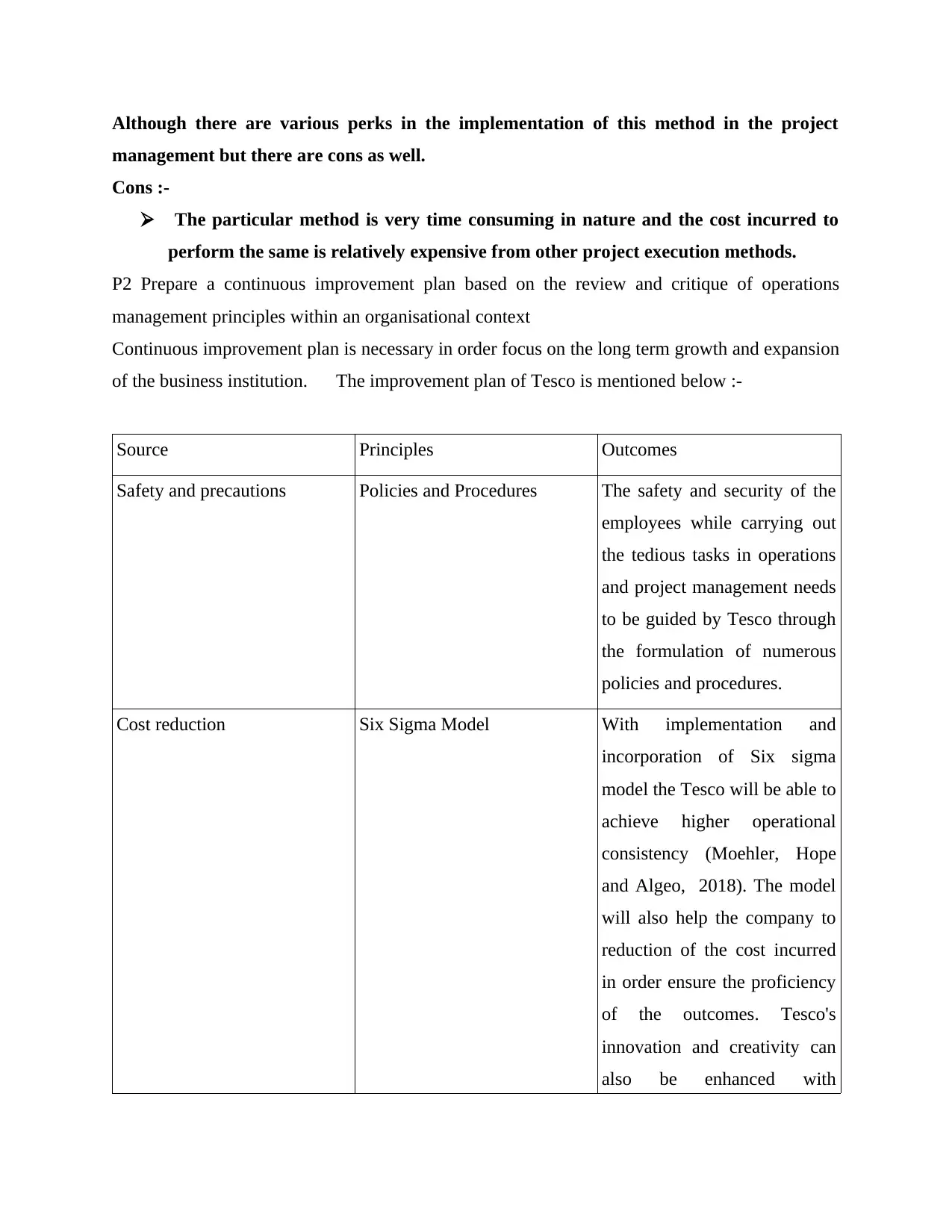
Although there are various perks in the implementation of this method in the project
management but there are cons as well.
Cons :-
The particular method is very time consuming in nature and the cost incurred to
perform the same is relatively expensive from other project execution methods.
P2 Prepare a continuous improvement plan based on the review and critique of operations
management principles within an organisational context
Continuous improvement plan is necessary in order focus on the long term growth and expansion
of the business institution. The improvement plan of Tesco is mentioned below :-
Source Principles Outcomes
Safety and precautions Policies and Procedures The safety and security of the
employees while carrying out
the tedious tasks in operations
and project management needs
to be guided by Tesco through
the formulation of numerous
policies and procedures.
Cost reduction Six Sigma Model With implementation and
incorporation of Six sigma
model the Tesco will be able to
achieve higher operational
consistency (Moehler, Hope
and Algeo, 2018). The model
will also help the company to
reduction of the cost incurred
in order ensure the proficiency
of the outcomes. Tesco's
innovation and creativity can
also be enhanced with
management but there are cons as well.
Cons :-
The particular method is very time consuming in nature and the cost incurred to
perform the same is relatively expensive from other project execution methods.
P2 Prepare a continuous improvement plan based on the review and critique of operations
management principles within an organisational context
Continuous improvement plan is necessary in order focus on the long term growth and expansion
of the business institution. The improvement plan of Tesco is mentioned below :-
Source Principles Outcomes
Safety and precautions Policies and Procedures The safety and security of the
employees while carrying out
the tedious tasks in operations
and project management needs
to be guided by Tesco through
the formulation of numerous
policies and procedures.
Cost reduction Six Sigma Model With implementation and
incorporation of Six sigma
model the Tesco will be able to
achieve higher operational
consistency (Moehler, Hope
and Algeo, 2018). The model
will also help the company to
reduction of the cost incurred
in order ensure the proficiency
of the outcomes. Tesco's
innovation and creativity can
also be enhanced with
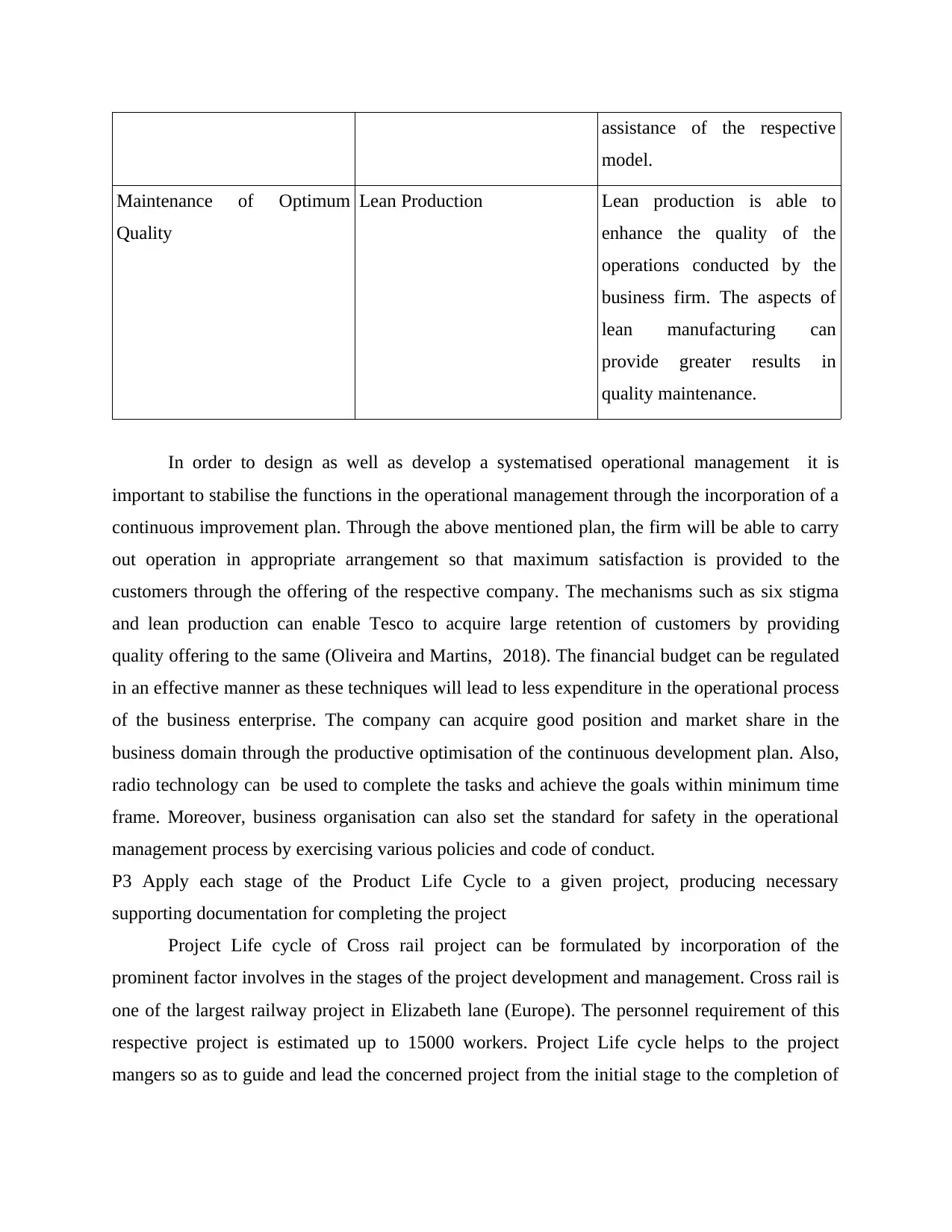
assistance of the respective
model.
Maintenance of Optimum
Quality
Lean Production Lean production is able to
enhance the quality of the
operations conducted by the
business firm. The aspects of
lean manufacturing can
provide greater results in
quality maintenance.
In order to design as well as develop a systematised operational management it is
important to stabilise the functions in the operational management through the incorporation of a
continuous improvement plan. Through the above mentioned plan, the firm will be able to carry
out operation in appropriate arrangement so that maximum satisfaction is provided to the
customers through the offering of the respective company. The mechanisms such as six stigma
and lean production can enable Tesco to acquire large retention of customers by providing
quality offering to the same (Oliveira and Martins, 2018). The financial budget can be regulated
in an effective manner as these techniques will lead to less expenditure in the operational process
of the business enterprise. The company can acquire good position and market share in the
business domain through the productive optimisation of the continuous development plan. Also,
radio technology can be used to complete the tasks and achieve the goals within minimum time
frame. Moreover, business organisation can also set the standard for safety in the operational
management process by exercising various policies and code of conduct.
P3 Apply each stage of the Product Life Cycle to a given project, producing necessary
supporting documentation for completing the project
Project Life cycle of Cross rail project can be formulated by incorporation of the
prominent factor involves in the stages of the project development and management. Cross rail is
one of the largest railway project in Elizabeth lane (Europe). The personnel requirement of this
respective project is estimated up to 15000 workers. Project Life cycle helps to the project
mangers so as to guide and lead the concerned project from the initial stage to the completion of
model.
Maintenance of Optimum
Quality
Lean Production Lean production is able to
enhance the quality of the
operations conducted by the
business firm. The aspects of
lean manufacturing can
provide greater results in
quality maintenance.
In order to design as well as develop a systematised operational management it is
important to stabilise the functions in the operational management through the incorporation of a
continuous improvement plan. Through the above mentioned plan, the firm will be able to carry
out operation in appropriate arrangement so that maximum satisfaction is provided to the
customers through the offering of the respective company. The mechanisms such as six stigma
and lean production can enable Tesco to acquire large retention of customers by providing
quality offering to the same (Oliveira and Martins, 2018). The financial budget can be regulated
in an effective manner as these techniques will lead to less expenditure in the operational process
of the business enterprise. The company can acquire good position and market share in the
business domain through the productive optimisation of the continuous development plan. Also,
radio technology can be used to complete the tasks and achieve the goals within minimum time
frame. Moreover, business organisation can also set the standard for safety in the operational
management process by exercising various policies and code of conduct.
P3 Apply each stage of the Product Life Cycle to a given project, producing necessary
supporting documentation for completing the project
Project Life cycle of Cross rail project can be formulated by incorporation of the
prominent factor involves in the stages of the project development and management. Cross rail is
one of the largest railway project in Elizabeth lane (Europe). The personnel requirement of this
respective project is estimated up to 15000 workers. Project Life cycle helps to the project
mangers so as to guide and lead the concerned project from the initial stage to the completion of
⊘ This is a preview!⊘
Do you want full access?
Subscribe today to unlock all pages.

Trusted by 1+ million students worldwide
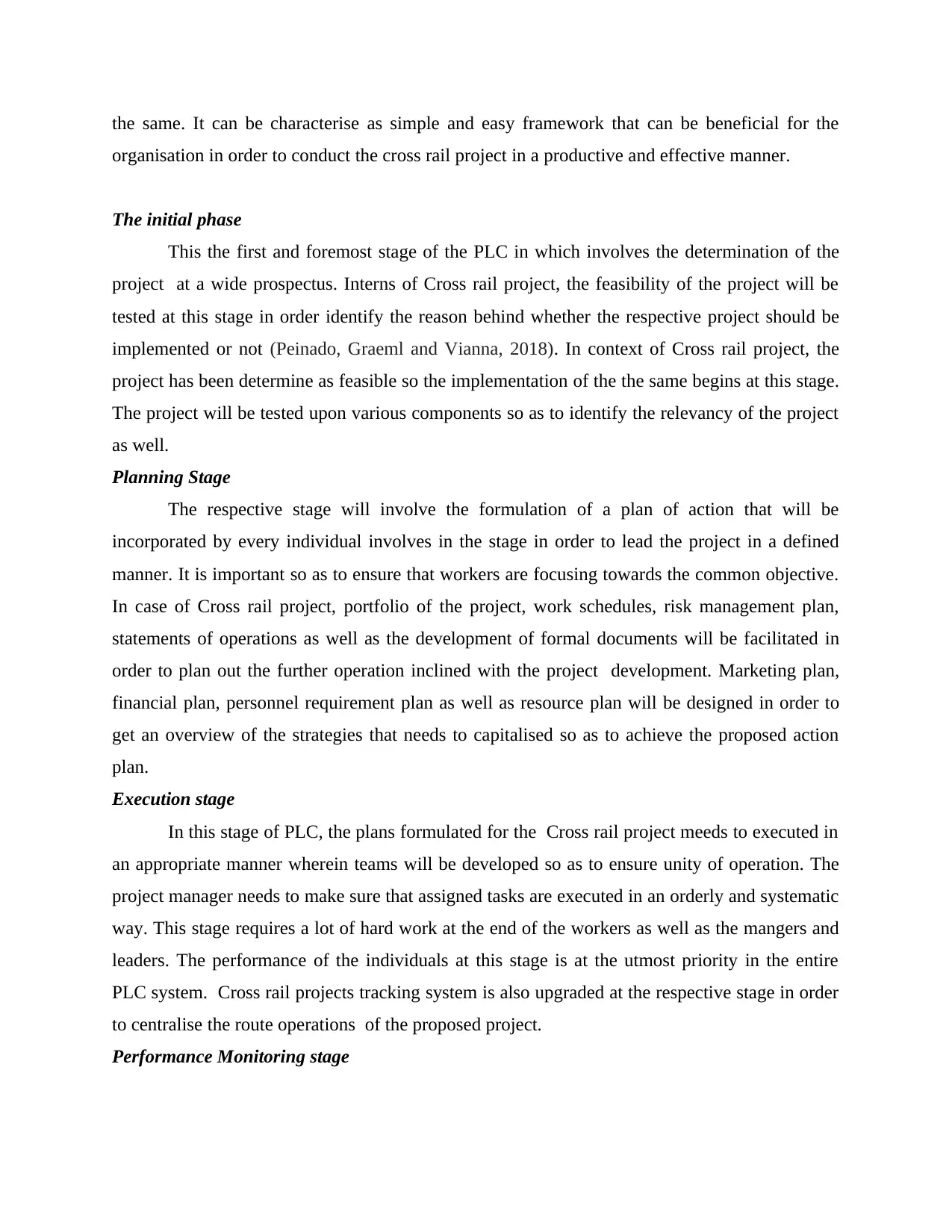
the same. It can be characterise as simple and easy framework that can be beneficial for the
organisation in order to conduct the cross rail project in a productive and effective manner.
The initial phase
This the first and foremost stage of the PLC in which involves the determination of the
project at a wide prospectus. Interns of Cross rail project, the feasibility of the project will be
tested at this stage in order identify the reason behind whether the respective project should be
implemented or not (Peinado, Graeml and Vianna, 2018). In context of Cross rail project, the
project has been determine as feasible so the implementation of the the same begins at this stage.
The project will be tested upon various components so as to identify the relevancy of the project
as well.
Planning Stage
The respective stage will involve the formulation of a plan of action that will be
incorporated by every individual involves in the stage in order to lead the project in a defined
manner. It is important so as to ensure that workers are focusing towards the common objective.
In case of Cross rail project, portfolio of the project, work schedules, risk management plan,
statements of operations as well as the development of formal documents will be facilitated in
order to plan out the further operation inclined with the project development. Marketing plan,
financial plan, personnel requirement plan as well as resource plan will be designed in order to
get an overview of the strategies that needs to capitalised so as to achieve the proposed action
plan.
Execution stage
In this stage of PLC, the plans formulated for the Cross rail project meeds to executed in
an appropriate manner wherein teams will be developed so as to ensure unity of operation. The
project manager needs to make sure that assigned tasks are executed in an orderly and systematic
way. This stage requires a lot of hard work at the end of the workers as well as the mangers and
leaders. The performance of the individuals at this stage is at the utmost priority in the entire
PLC system. Cross rail projects tracking system is also upgraded at the respective stage in order
to centralise the route operations of the proposed project.
Performance Monitoring stage
organisation in order to conduct the cross rail project in a productive and effective manner.
The initial phase
This the first and foremost stage of the PLC in which involves the determination of the
project at a wide prospectus. Interns of Cross rail project, the feasibility of the project will be
tested at this stage in order identify the reason behind whether the respective project should be
implemented or not (Peinado, Graeml and Vianna, 2018). In context of Cross rail project, the
project has been determine as feasible so the implementation of the the same begins at this stage.
The project will be tested upon various components so as to identify the relevancy of the project
as well.
Planning Stage
The respective stage will involve the formulation of a plan of action that will be
incorporated by every individual involves in the stage in order to lead the project in a defined
manner. It is important so as to ensure that workers are focusing towards the common objective.
In case of Cross rail project, portfolio of the project, work schedules, risk management plan,
statements of operations as well as the development of formal documents will be facilitated in
order to plan out the further operation inclined with the project development. Marketing plan,
financial plan, personnel requirement plan as well as resource plan will be designed in order to
get an overview of the strategies that needs to capitalised so as to achieve the proposed action
plan.
Execution stage
In this stage of PLC, the plans formulated for the Cross rail project meeds to executed in
an appropriate manner wherein teams will be developed so as to ensure unity of operation. The
project manager needs to make sure that assigned tasks are executed in an orderly and systematic
way. This stage requires a lot of hard work at the end of the workers as well as the mangers and
leaders. The performance of the individuals at this stage is at the utmost priority in the entire
PLC system. Cross rail projects tracking system is also upgraded at the respective stage in order
to centralise the route operations of the proposed project.
Performance Monitoring stage
Paraphrase This Document
Need a fresh take? Get an instant paraphrase of this document with our AI Paraphraser
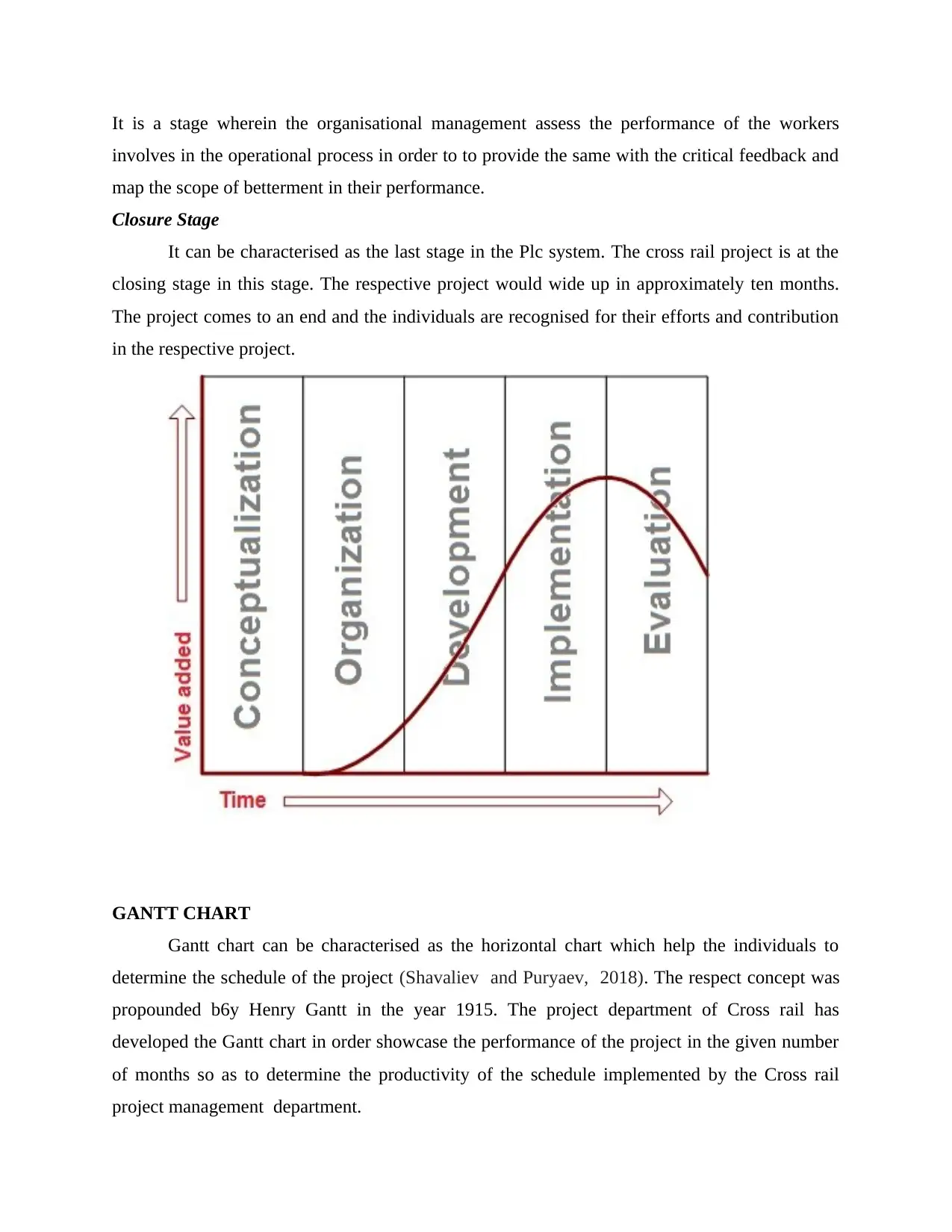
It is a stage wherein the organisational management assess the performance of the workers
involves in the operational process in order to to provide the same with the critical feedback and
map the scope of betterment in their performance.
Closure Stage
It can be characterised as the last stage in the Plc system. The cross rail project is at the
closing stage in this stage. The respective project would wide up in approximately ten months.
The project comes to an end and the individuals are recognised for their efforts and contribution
in the respective project.
GANTT CHART
Gantt chart can be characterised as the horizontal chart which help the individuals to
determine the schedule of the project (Shavaliev and Puryaev, 2018). The respect concept was
propounded b6y Henry Gantt in the year 1915. The project department of Cross rail has
developed the Gantt chart in order showcase the performance of the project in the given number
of months so as to determine the productivity of the schedule implemented by the Cross rail
project management department.
involves in the operational process in order to to provide the same with the critical feedback and
map the scope of betterment in their performance.
Closure Stage
It can be characterised as the last stage in the Plc system. The cross rail project is at the
closing stage in this stage. The respective project would wide up in approximately ten months.
The project comes to an end and the individuals are recognised for their efforts and contribution
in the respective project.
GANTT CHART
Gantt chart can be characterised as the horizontal chart which help the individuals to
determine the schedule of the project (Shavaliev and Puryaev, 2018). The respect concept was
propounded b6y Henry Gantt in the year 1915. The project department of Cross rail has
developed the Gantt chart in order showcase the performance of the project in the given number
of months so as to determine the productivity of the schedule implemented by the Cross rail
project management department.
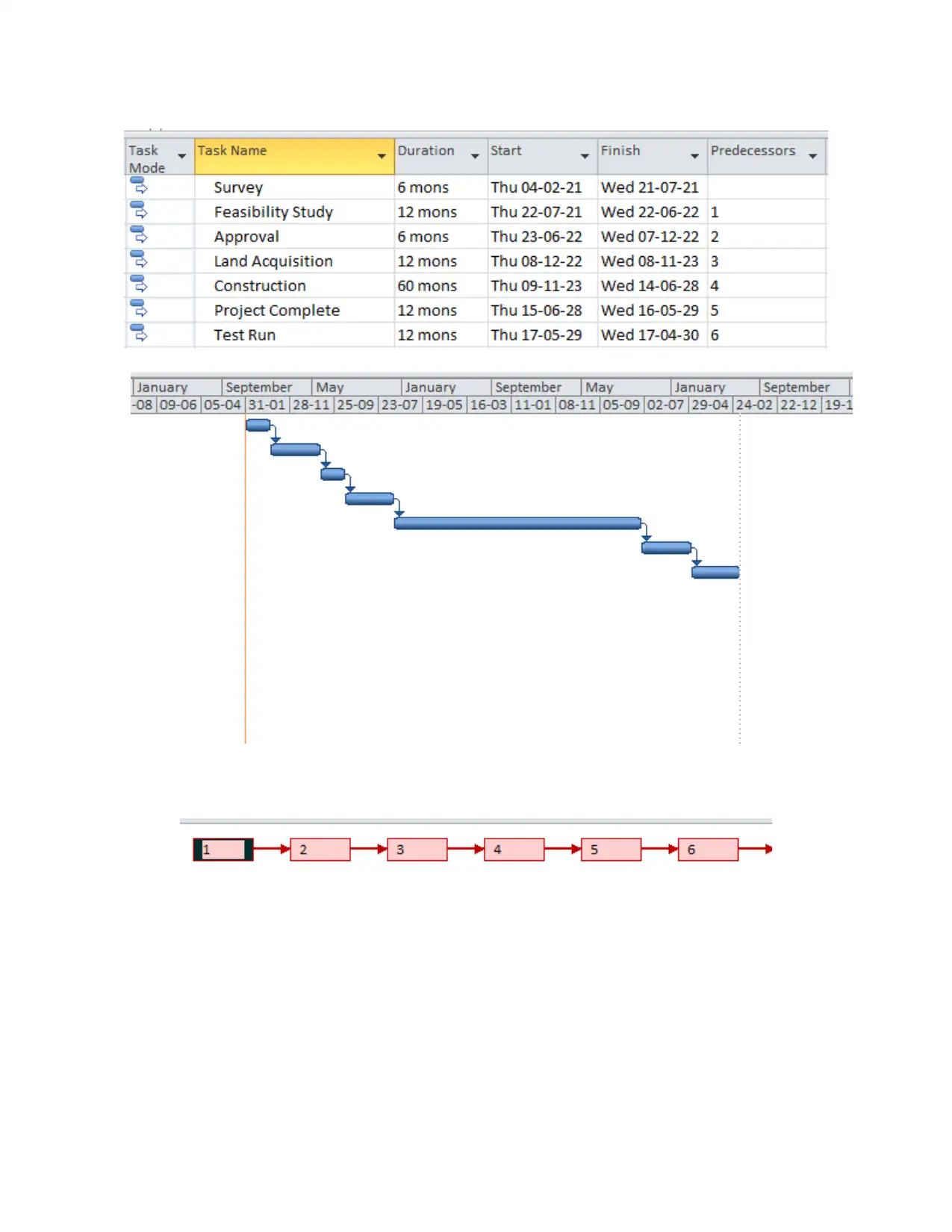
⊘ This is a preview!⊘
Do you want full access?
Subscribe today to unlock all pages.

Trusted by 1+ million students worldwide
1 out of 18
Related Documents
Your All-in-One AI-Powered Toolkit for Academic Success.
+13062052269
info@desklib.com
Available 24*7 on WhatsApp / Email
![[object Object]](/_next/static/media/star-bottom.7253800d.svg)
Unlock your academic potential
Copyright © 2020–2025 A2Z Services. All Rights Reserved. Developed and managed by ZUCOL.





